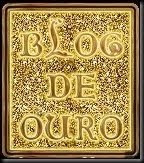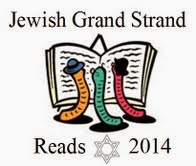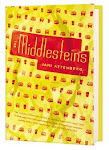Wednesday, December 22, 2010
Hadassah's 2010 Ribalow Prize Winner
Sara Houghteling has been awarded for 2010 The Harold U. Ribalow Prize award by Hadassah, for her novel, Pictures at an Exhibition.
The award is given each year by the Jewish zionist women's organization each year. It is a annually award for Jewish fiction. It must be written in the english language, and either be written in short story or novel form.
You can read Hadassah magazine's, December/January issue with a excerpt of her novel. Read the article in the Forward about the the background of her novel.
Born to an art dealer and his pianist wife, Max Berenzon is forbidden from entering the family business for reasons he cannot understand. He reluctantly attends medical school, reserving his true passion for his father s beautiful and brilliant gallery assistant, Rose Clément. When Paris falls to the Nazis, the Berenzons survive in hiding. They return in 1944 to find that their priceless collection has vanished. Madly driven to recover his father s paintings, Max navigates a torn city of corrupt art dealers, black marketers, Résistants, and collaborators. His quest will reveal the tragic disappearance of his closest friend, the heroism of his lost love, and the truth behind a devastating family secret.
Sara Houghteling graduated from Harvard College in 1999 and received her master's in fine arts from the University of Michigan. She is the recipient of a Fulbright scholarship to Paris, first prize in the Avery and Jules Hopwood Awards, and a John Steinbeck Fellowship. She currently lives in California, where she teaches high school English.
Mazel Tov !! Sara
This was taken from Hadassah's magazine's article:
Sara Houghteling lives in Berkeley, California, and grew up in Brookline, Massachusetts, she is in love with Paris. It is the setting of her first novel, Pictures at an Exhibition (Vintage), winner of this year’s Harold U. Ribalow Prize. She began her work on the novel while she was on a Fulbright Scholarship in the French capital in 2005. “It was an opportunity to focus on French art, French music, French
history,” Houghteling, 33, says. “It kept calling me back.”
Pictures is the story of Max Berenzon, the only son of a successful Jewish art dealer, in the years leading up to and following the fall of Paris during World War II. The family survives in hiding, but they return to the city to find their priceless art collection gone and Paris shrouded in duplicity and silence. Max chases his dual obsessions: his father’s paintings and former assistant, Rose Clément.
The Harvard College graduate didn’t know much about Nazi looted art when she began her research, inspired by Lynn H. Nicholas’s The Rape of Europa (Vintage). She found it “strange, distressing and complicated” how the systematic plunder unfolded. “It’s horrifying,” she adds, that the Nazis used the deportation of Jews to gather art for their personal benefit, aesthetic purposes and to finance the Final Solution.
Houghteling learned that after the war European art dealers went into what she calls “lockdown mode” to protect each other. “They all had benefited in some way from what was done to the Jewish art dealers and collectors,” she explains.
She also came across the out-of-print autobiography of Rose Valland, former curator of Jeu de Paume national gallery—on whom she based the character of Rose Clément. “The real Rose was incredibly heroic,” says Houghteling. “It is mind-boggling how one woman almost single-handedly orchestrated a complex plan to outwit the Nazis in their final plunder,” by notifying the Allies and resistance groups about the movement of trains containing artworks, saving thousands of France’s masterpieces from destruction.
In addition to her own love of Paris, her father lived in France after World War II, where her grandfather worked on the Marshall Plan. “Having their perspective on France after the war set the stage [for the book],” she says. Also thanks to them, Houghteling learned French, though she admits to having “a good accent, but comic grasp of grammar.”
The author’s love of music—she studied at the New England Conservatory as a youngster—is evident in the novel. In fact, the title is borrowed from the 1874 piano suite by Modest Mussorgsky. The exhibit that inspired the composer had been taken down, she explains, “and all that is left is the haunting remains of what was.”
Houghteling teaches high school English at a Berkeley private school. Her husband, Daniel Mason, is also a fiction writer; the couple spent four months in France recently, both on fellowships from the Camargo Foundation in Cassis, near Marseilles, where Houghteling worked on her second novel.
The designation of Jewish writer is one that Houghteling, who grew up belonging to a Reform temple, accepts with no misgivings. “Judaism is so much a part of my identity that my characters most easily tend to be Jewish,” she says. “Judaism is the melody in the back of my head.” Plus, she adds, “primarily when dealing with World War II era, the ’30s through the ’50s—the time period that preoccupies me the most—I can’t write without thinking what it was like to be Jewish at that time.”
In fact, she says, the experience that “solidified [her] Jewish identity” was her job as editorial assistant to Holocaust survivor Emmanuel Tanay, which she did while earning her master’s of fine arts at the University of Michigan in Ann Arbor. Tanay was working on a memoir of his childhood in Poland. “I had always been drawn to the Holocaust,” she adds, “but the sustained immersion in another person’s life from that era [was incomparable].”
Sunday, December 19, 2010
Guest Post Judy Gelman and Vicki Levy Krupp
.
I am honored today, with a guest post by co-authors, Judy Gelman and Vicki Levy Krupp. They have written a marvelous book called Table Of Contents Cook Book, From Breakfast with Anita Diamant to Dessert with James Patterson.
A few months ago I was looking for authors to donate books for our temple's auction. I already spoke to a few authors. One such author was Anita Diamant. I got the idea for our book club book basket to ask Judy and Vicki since Anita's donated her book. Their book, Table of Contents has Anita and her book featured. I thought what a great idea to have both books in a book basket. I took a gamble. They were sweet and they donated a copy.
A few months ago I was looking for authors to donate books for our temple's auction. I already spoke to a few authors. One such author was Anita Diamant. I got the idea for our book club book basket to ask Judy and Vicki since Anita's donated her book. Their book, Table of Contents has Anita and her book featured. I thought what a great idea to have both books in a book basket. I took a gamble. They were sweet and they donated a copy.
Judy and Vicki met over stacks of books, and endless cups of jo at a local sandwich shop. They decided to try their hand atThe Book Club Cookbook, followed by Kids Book Club Book and Table of Contents. They also have a marvelous website, Book Club Cook Book, with enormous resources for book clubs. You would find food pairing with a favorite book. Information about the author. Loads of resource information for your book club.
Welcome Judy and Vicki,
Hi everybody,
We envisioned our new book, Table of Contents
as a compilation of intriguing recipes drawn from the works of 50 bestselling authors. When we began our research, we were unsure what the combination of authors would be. After all, there are hundreds of authors popular with book clubs. And, some of their books lend themselves better to recipes than others. How would we choose?
As it turns out, the process unfolded naturally. We quickly identified our “wish list” of participating authors, based on ongoing correspondence with book clubs, thorough searches of bestseller lists, and daily monitoring of book club and reading websites. Many invited authors signed on immediately, while some declined because other projects took precedence, or even because they lacked interest in the topic: food and literature. The self-selection process meant we were left with authors as fascinated by the topic of food and books as we ourselves were, and 50 wonderful partnerships were born.
We felt fortunate to work with this eclectic, intriguing, ethnically diverse selection of authors. Book club members have been telling us for years that they love being transported to exotic locales and distant times through their reading. It was no surprise to find Abraham Verghese, Frances Mayes, and Esmeralda Santiago on our list, with books set in Ethiopia, Italy, and Puerto Rico. Readers also seem to love stories set in the South, so Amy Greene, Joshilyn Jackson, and Hillary Jordan were natural choices. Writers of historical fiction who transport readers to times gone by -- Tudor England (Phillipa Gregory) and wartime Hong Kong (Janice Y.K. Lee), for example -- also made the grade.
Of course, this selection of authors and titles translated into tantalizing, exotic recipes! We love Lisa See’s Won Tons, that she makes with her family every year at Thanksgiving. And Stephanie Saldana, who spent several years traveling and living in the Middle East, sent us a recipe for Muhammara (Roasted Red Pepper Dip with Walnuts and Pomegranate Syrup), the smell and taste of which carries the cook to the winding streets of Damascus, Syria. And there are so many more examples! Readers tell us they enjoy experiencing some of these ethnic foods for the first time, and preparing and eating these dishes helps them connect with the setting and time period of the book.
As we embark on our new project, a revision of our first book, The Book Club Cookbook, we look forward to sharing more recipes and insights from bestselling authors. We hope this will continue to enhance readers' understanding of these books, and of course to add another important element to book club meetings - fun!
Bon Appetit!
Judy Gelman and Vick i Levy Krupp
Subscribe to:
Posts (Atom)























.jpeg)








